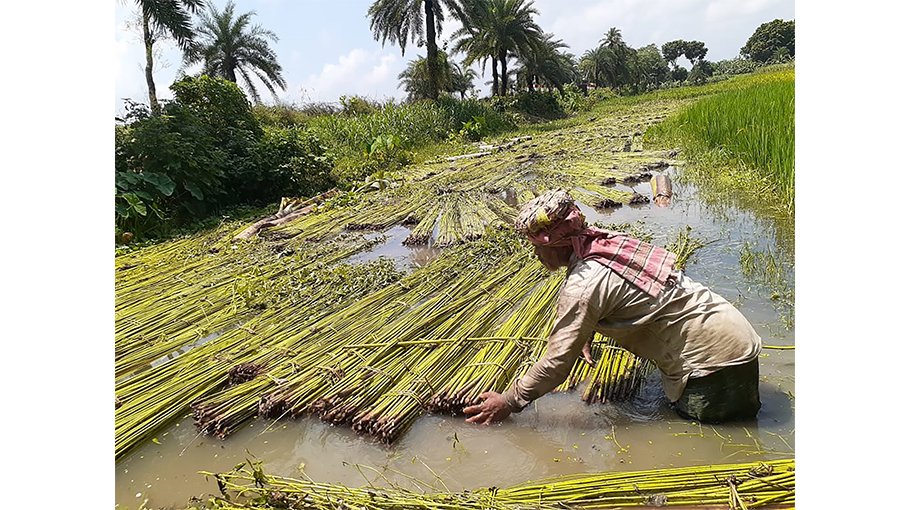Water scarcity affects jute retting in Chuadanga
Canals, ponds have dried up due to scanty rainfall


Jute farmers in Chuadanga district are facing huge trouble to rot and process the natural fibre as different water bodies, including Beels, canals and ponds, have dried up there due to scanty rain during the monsoon.
High yield of jute fails to make the growers happy. They are worried about jute processing in the absence of water in local water bodies. Even though the month of Shraban is coming to an end, there is not enough rain in the district during the rainy season.
For this reason, farmers are using other people's reservoirs in exchange for money while many farmers are waiting for rain. They are not cutting the jute plants even though it is time to cut them. Many jute fields are drying up. Farmers claim that if jute is not processed at the right time, they will suffer losses.
Sources in the Chuadanga Department of Agricultural Extension said farmers have cultivated jute on 7,460 hectares of land in four upazilas of the district in the current season. Of them, jute has been cultivated on 425 hectares of land in Sadar upazila, 2,570 hectares of land in Alamdanga upazila, 3,270 hectares of land in Damurhuda upazila and 1,195 hectares of land in Jibannagar upazila.
However, as there is no water in the water bodies, the farmers are worried about jute retting. Some farmers are lifting water with water pumps and depositing it in reservoirs for jute retting in that reservoir. As the cost is high, the profit figure is decreasing.
This year, farmers have spent Tk 10,000 to Tk 13,000 per bigha of land for jute cultivation. And per maund jute is being sold from Tk 2,000 to Tk 2,300. The yield of jute per bigha is also 10 maunds or more. The jute growers are benefiting after cutting all costs.
Abid Hossain, a jute grower of Santoshpur village in Jibannagar upazila, said this year he cultivated jute on one acre of land. Jute yield has also been good. “But due to lack of water, I can't cut jute plants and process jute. I have rented a pond. A machine will be used to give water in the pond and the process is very expensive.”
Md Zahurul Haque, another jute farmer of the same village, said, “This year I cannot process jute due to lack of water. Next to the house, I have kept the jute plants in the muddy water. Now I am waiting for rain.”
Jute grower Abdus Salam of Begumpur village in Sadar Upazila said this year he cultivated jute on five Bighas of land. On an average, Tk 13,000 has been spent for jute cultivation on each Bigha of land. “Due to the lack of water in the water bodies, I was worried about jute processing. Later, I used a water pump to give water in a ditch near the house. I have kept the jute plants there for retting,” he said.
Farmers of the area said the price of jute is better this year than that of last year. The yield is also good. If they get a good price, there will be more interest in jute cultivation in the future. As a result, jute cultivation will increase. Along with jute, the demand for jute sticks is also high. Jute sticks worth about Tk 8,000 are sold from each bigha of land. All the farmers are happy. Jute stick is in great demand for fuel works and fencing. For this, the price and demand for jute is increasing day by day.
Bibhas Chandra Saha, deputy director of Chuadanga Department of Agricultural Extension, said the farmers have started cutting jute plants on the land. Now, the big problem is jute rotting. Due to lack of water, the farmers are not able to rot jute properly. “We suggest farmers to decompose jute by ribbon rating system at low cost. By decomposing jute in this way, the fibre quality of jute is better. If you can produce good quality jute, you can get good price. They will benefit from it,” he said.
He also said due to the favourable weather, jute cultivation has been good this year and the condition of jute is also good. Even if there is no rain, jute production will not be disrupted. But heavy rains would have been more beneficial for the farmers.


